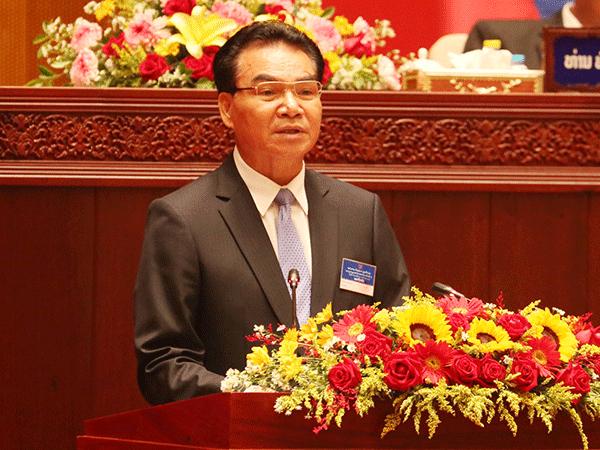Govt proposes 5.3 trillion kip for 2025 socio-economic development
The Ministry of Planning and Investment on Monday unveiled an initial investment budget of 5,300 billion kip, marking a 6 percent increase compared to the budget for 2024.
 |
| Minister of Planning and Investment Dr Phet Phomphiphak delivers a report at the National Assembly on Monday. |
Speaking at the opening of the 8th Ordinary Session of the National Assembly, Minister of Planning and Investment Dr Phet Phomphiphak told National Assembly (NA) members that this amount excludes an additional budget of 150 billion kip, as announced by the Ministry of Finance.
“This means the total investment budget for 2025 will amount to 5,450 billion kip. The details of this budget will be discussed after the Ministry of Finance issues formal notification,” Dr Phet said.
Of the initial 5,300 billion kip, 5,150 billion kip is classified as the general budget, with funds to be allocated for the government’s priority programmes and the regular projects or targeted projects of various ministries, organisations, and localities.
The state investment goals for 2025 focus on strengthening the response to natural disasters, improving socio-economic infrastructure, developing rural areas, and alleviating poverty.
Additionally, the budget will be spent on improving roads in production areas, enhancing services related to the Laos-China railway, facilitating the transportation of goods to export markets, and developing infrastructure to promote revenue collection and support tourism.
The budget will also fund critical projects related to national defence and public security. Initiatives such as skills training, job creation, technical training, science and technology transformation, and digital system modernisation will also receive allocations.
Simultaneously, funds will be allocated for medical equipment, educational tools, resources to boost revenue collection, and facilities for labour skill development. Monitoring the implementation of socio-economic development and investment plans, particularly in sectors specified under the law on state investment, is another priority.
The government also plans to invest in creating production models, promoting robust domestic production, and ensuring food security. Renovation of dilapidated infrastructure, including office buildings, electrical systems, water supply systems, and roof repairs, is also deemed essential to ensure usability.
Earlier this year, the National Assembly approved a state investment plan of 5,000 billion kip, representing a 15.8 percent increase compared to 2023.
This amount included debt repayment capital of 803.32 billion kip (16 percent of the total), ongoing project capital of 3,232.67 billion kip (65 percent), and proposed new project capital of 964.01 billion kip (19 percent).
These funds were divided into two groups: general investment (2,900 billion kip) and accounts payable and other outlays (2,100 billion kip).
In the first nine months of 2024, a total of 6,839 projects worth 4,013.41 billion kip were implemented, representing 80 percent of the target figure.
Within the general investment category, the government’s priority projects (comprising nine priority goals) included 1,775 projects valued at 806.35 billion kip, achieving 85 percent of the set target.
Regular capital and special target capital funded 4,048 projects worth 1,522.06 billion kip, achieving 78 percent of the planned target. For accounts payable and other outlays, 1,016 projects worth 1,685 billion kip were implemented, equalling 80 percent of the target figure.
Next year, 49 percent of investment capital will be allocated to the central government, while 51 percent will be distributed to localities, under the government’s proportionate investment structure for 2025 reported on the first day of the National Assembly sitting.
By Times Reporters
(Latest Update November 20, 2024)
|


